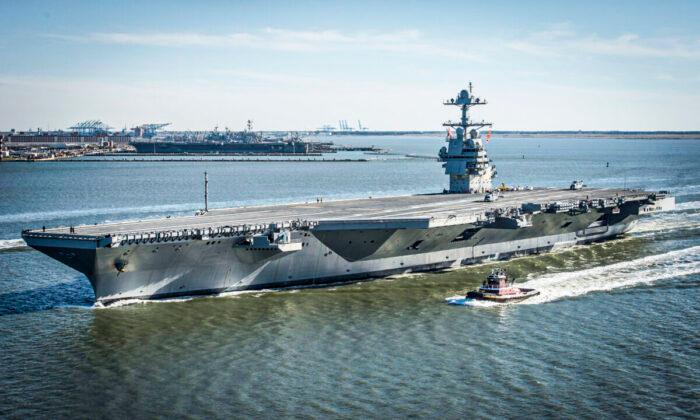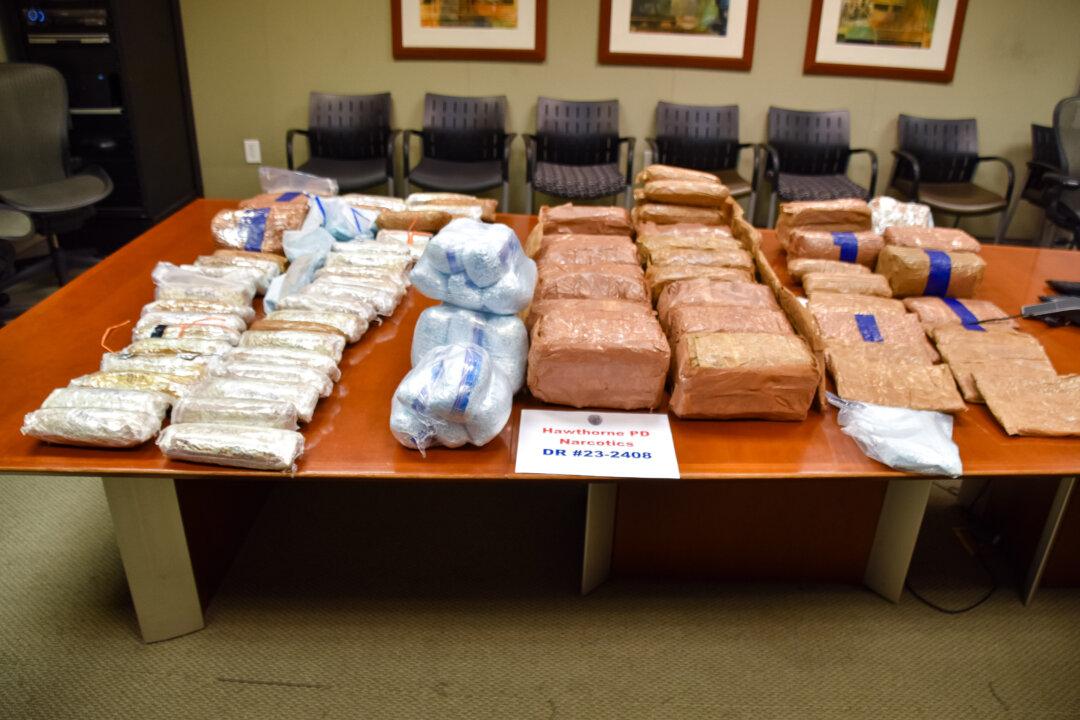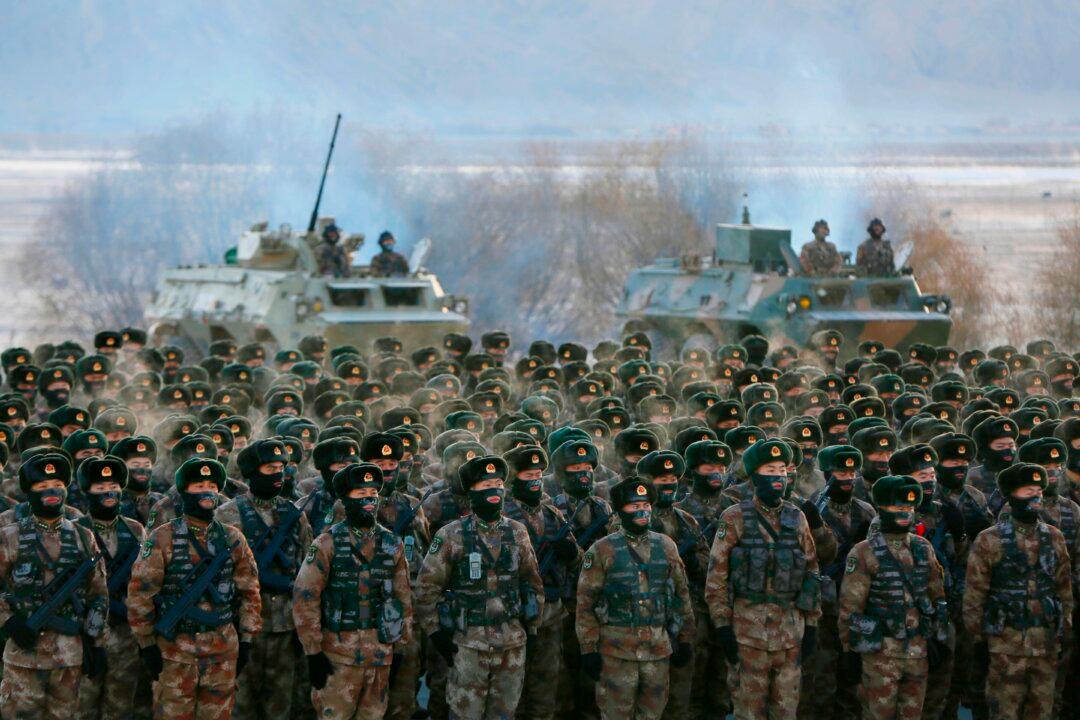Commentary
The U.S. Navy has been struggling for years to maintain the production and maintenance throughput of its four government shipyards and approximately eight major private sector yards. The chief of naval operations, Adm. Michael Gilday, has established the clear, quantifiable shortfall.
Until the 2023 National Defense Authorization Act (NDAA), two Arleigh Burke destroyers and two Virginia submarines were being purchased a year,
yet only 1.8 and 1.2 were being delivered a year. This means the destroyers and submarines were 10 percent and 40 percent behind schedule, respectively. With the 2023 NDAA, which increases the purchase of each to three a year (and doesn’t count the new
Columbia ballistic missile submarine, which will be built in the same shipyards), the straight-line throughput at current delays will be only 2.7 destroyers and 1.8 submarines delivered for three of each purchased. Complications from increased orders will possibly drive up the existing delivery delays.
The Navy’s “
analysis paralysis” on this topic has been festering for years, yet the throughput and trendlines have been worsening. Congress is spinning into action with a
flurry of trips to assess the situation. The issues are a lack of yard capacity, challenges in building a workforce, higher prices for materials, and companies leaving the industrial base and supply chain because of the erratic nature of the federal budget process.
Currently, all production and maintenance of ships is centralized in
four U.S. Naval Shipyards (NSYs)—Portsmouth (Maine), Norfolk (Virginia), Puget Sound (Washington), and Pearl Harbor (Hawaii)—and eight major private shipyards—Bath Iron Works, ElectricBoat, Newport News, Ingalls, Austal, Fincantieri, Philly, and NASSCO. If this industrial base is failing to meet throughput, then perhaps the time is now to consider re-opening a closed NSY and a new private shipyard (or two).
Re-Open a Closed US Government Shipyard?
The four existing U.S. NSYs are survivors of a once
much larger industrial base. They don’t build ships anymore but are used to fix and repair ships and submarines (called “
maintenance availabilities”). These proud facilities are woefully in need of re-capitalization, and the Navy is doing this through the
Shipyard Infrastructure Optimization Program, but the program isn’t expanding much-needed yard square footage. Modernized Navy yards will still be crowded and cramped. There are now hints of discussion about re-opening a dormant Navy yard; the question is, which one?
Building a “greenfield” NSY would be a mammoth undertaking in the modern era. The options in geographic choices are limited, but since the orientation of the main concern is the Pacific, the three that come to mind for re-opening are Mare Island NSY, San Francisco NSY, and Long Beach NSY, all on the West Coast.
Mare Island NSY in Vallejo, California, has been fallow since its closure, other than being used as a stage for “Mythbusters.” Moving a ship larger than a destroyer up to this historical facility would require extensive civil engineering and dredging. San Francisco NSY is larger and has more space.
There’s only one aircraft carrier dry dock in the entire Pacific, Dry Dock 6 at Puget Sound NSY (
pdf), but it may or
may not be out of commission following announcements by the Navy. Unbelievably, there’s no dry dock in the Pacific that can take a Ford-class aircraft carrier. An additional dry dock that can take both the Nimitz class and now the new Ford class is desperately needed in the Pacific.
The old San Francisco NSY is best able to fit a new dry dock of this immense size. Its
large crane structure is iconic on the San Francisco skyline; it was designed to rapidly swap out turrets on battleships and then was used to launch test Polaris missiles on tethers in the late 1950s/early 1960s.
Long Beach NSY is no more—its drydocks have been filled in and its cranes and workshops have been removed, and it’s now encumbered by the Port of Long Beach, one of the largest container terminals in the world.
Taking these stated factors into consideration, the intuitive conclusion is that the San Francisco NSY is the logical facility to re-open. There are long-range plans to commercially develop the site, which would have to be addressed. There may be a need to argue that urgent national security imperatives require the facility be put back into federal use. The Long Beach NSY facility would be challenging to re-open, but if trade friction continues and
inbound containers continue to decline, then perhaps this facility may be an opportunity also.
The Navy staff has endlessly agonized over the ship repair capacity and throughput issue—the faster the policy issue is decided and plans and programs can be put in place, the faster the Navy can achieve at least a 25 percent increase in capacity.
In addition, an expeditionary rapid repair and regeneration capability is needed in Guam to promptly turn around battle-damaged ships. The
Titan Floating Drydock is one of a very small number of large floating dry docks in existence in America. It would be wise to move this now to Guam and build two or three more of these with alacrity. Floating dry docks, an
obscure topic that gathers little attention, were one of the key reasons for the U.S. Navy’s decisive victory in the Pacific in World War II.
Where, What, and How to Establish Additional Private Shipyard Capacity
The eight major private yards are at maximum capacity with their existing work, not including the increase in the need for destroyers, submarines, and many more vessels required to enable, support, and sustain the fleet. FY 2021 proposed legislation (
pdf) to authorize and appropriate $25 billion for the shipyards isn’t moving, and although there are strong elements in the FY 2023 NDAA, there isn’t precise language to assist the private shipyards in re-capitalization and expansion.
There are several key descriptors needed for a dedicated initiative for the private shipyards. The funds must be “ring-fenced” or protected for this purpose, the funds should be multi-year funds (most Department of Defense funds are single-year and have a small window to be obligated or else they’re subject to re-programming), and the shipyards need to significantly expand the square footage of their facilities, which means land acquisition.
Furthermore, the effort should emphasize digital engineering, model-based systems engineering, and the creation of large enclosures over the construction areas for maximum efficiency. The enclosures provide a much better environment for the workers, which means greater efficiency and safety. If Disney can have their mammoth cruise vessels
built entirely indoors, there’s no reason the U.S. public and private yards can’t graduate into the 21st century. These enclosures provide security from prying eyes and protection from drone swarms that may be marshaled on demand from Huawei-provisioned networks in the United States.
The expansion of the U.S. Navy and new facilities should also emphasize autonomous vessels and the production of advanced, non-nuclear submarines to complement the bigger Virginia and Columbia class. The U.S. Navy nuclear submarine fleet can be quite prickly on this subject, but the reality is that the Navy needs a much larger submarine fleet of both nuclear submarines and also smaller non-nuclear submarines that can be reserved for use in the Caribbean and the homeland littorals. The nuclear submarines can be emphasized for the Mid and Western Pacific.
Regarding the question of where a new “greenfield” (built for the purpose from scratch) shipyard could be located, a Pacific orientation makes sense, and if there are enough resources, a second one would make sense on the Gulf of Mexico. On the West Coast, there aren’t many options for a new yard without massive federal eminent domain claims of land and terraforming/backfilling of coastal harbors on a scale not seen recently in America.
One opportunity does stand out that provides a good running start: the dormant and closed
Alameda Naval Air Station (NAS). It was created by backfill expansion in the 1930s and is in the process of long-term handover from the Department of Defense to local developers and government. Like San Francisco NSY, it may be time to change plans because of the compelling national interest. With more land reclamation, there can be ample space for building a new, advanced, large shipyard.
Another possible site is the
Vigor main shipyard in Portland, Oregon, or a new site downriver on the Columbia River, closer to where it meets the Pacific Ocean. Land acquisition, expansion, and outfitting of the existing Vigor yard or a close-by satellite yard would be a large undertaking, but again the national security urgency is compelling.
Loss of the Panama Canal Should Be a Driving Factor
Gen. Laura Richardson and
Gen. Glen VanHerck, the commanders of Southern Command and Northern Command, respectively, have made it clear that they have serious concerns over the viability of the Panama Canal in case of conflict with China.
This amplifies the need for new government and private shipyards, with an emphasis on siting these on the West Coast of the United States. The slow wake-up of the Defense Industrial Base to meet the greatly expanded need for war material to support Ukraine should be a wake-up call for action on the Navy crisis in throughput.
A “Manhattan Project” is needed to spin the Navy industrial base into action. Army Gen. Leslie Groves made the Pentagon and Manhattan Project a reality in record time—an equivalent personality is needed now to build deterrence capacity against Chinese adventurism toward Taiwan or anywhere in the Pacific.
Views expressed in this article are opinions of the author and do not necessarily reflect the views of The Epoch Times.





